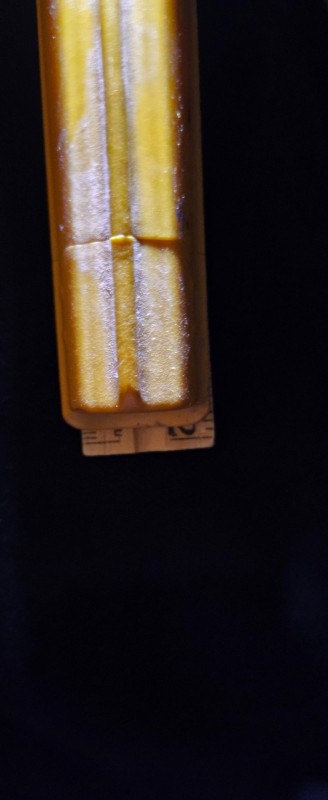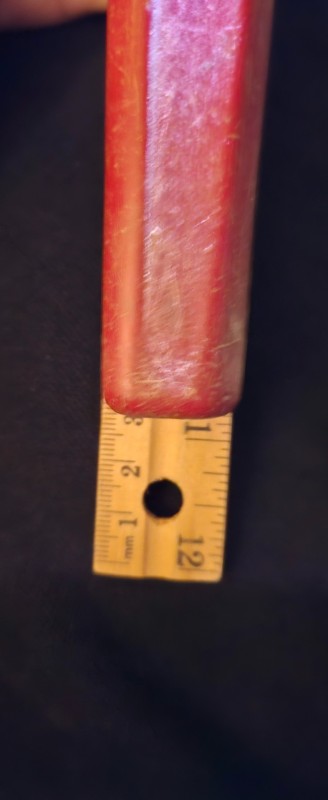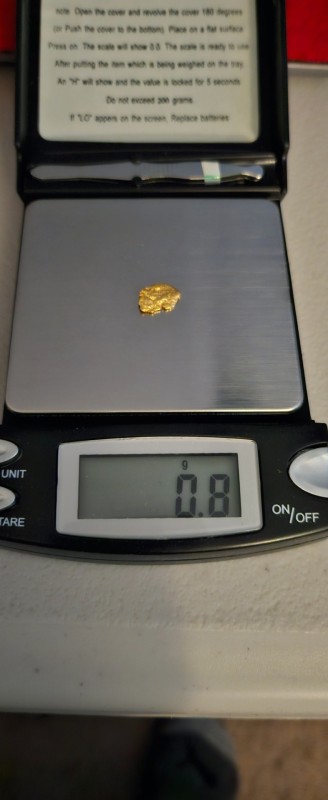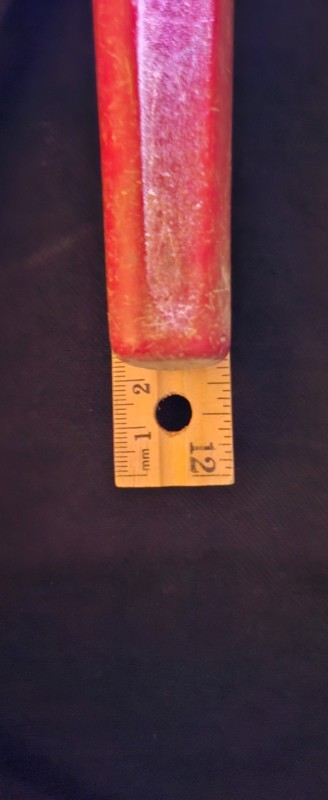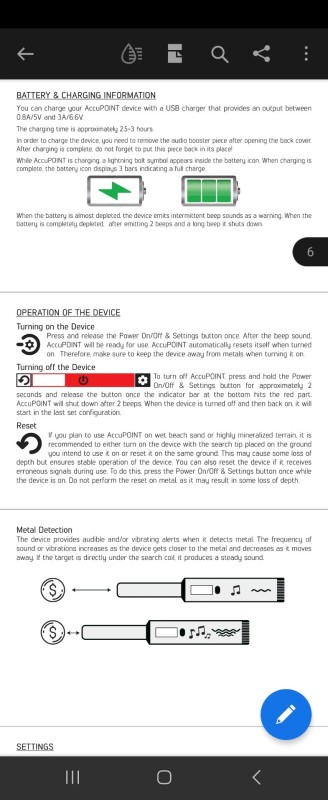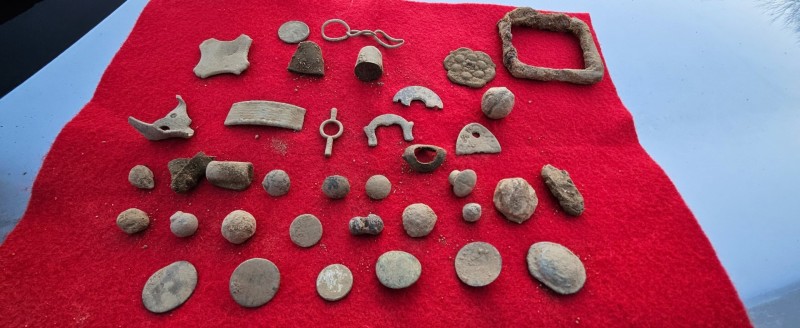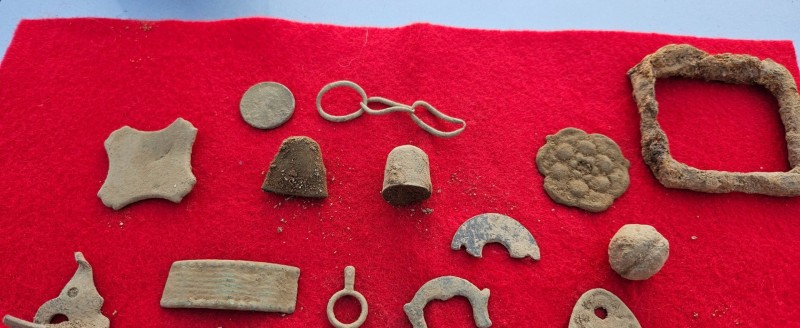-
Posts
6,132 -
Joined
-
Last visited
Content Type
Forums
Detector Prospector Home
Detector Database
Downloads
Everything posted by Chase Goldman
-
A little late to the party here. Having owned a Deus 1 for several years which I considered my best non SMF detector, especially with the white HF 9" coil, I was skeptical that something could totally replace it. I used an Equinox 800 and that complimented the Deus 1 well, but there were still situations where the Deus 1 excelled over the Nox. But after having used the Deus 2 for nearly two years now, I can say that my Deus 1 (and to a lesser extent also my Nox) have been collecting a lot of dust for the past two years. Subsequent to releasing the Deus 2, XP put out the WS6 Master package (smart puck in lieu of the remote) which is a great value and very capable with 99% of the features of the full remote package but at about $700US right now for "Black Friday"/Christmas deals. A great deal (and much more capable than analogous Deus 1 lite setup) and the coil operates up to 45Khz, as Jeff said above, which appeared to meet your minimum coil frequency needs. But I am a relic hunter and don't have to deal with steel clad coins. And that's all moot for you since you went ahead with the Deus 1. I posted the above regardless as it may help others who are contemplating the Deus 1 in 2024. Anyway...I had a question for you. Did you get the 9" HF coil or 9" X35 coil? It's not clear which coil you ordered (just says 9") from what you posted above and you mentioned an X35 package deal earlier for the same price you paid above. I ask because I thought you wanted something that gets you to 74khz or at least 40 khz. X35 only goes to 27khz and the 9" HF goes to 54 khz. Only the 9.5x5" elliptical goes to 74 khz. Did you end up changing your mind on desired max frequency? Edit: Nevermind, I see you are going to get the HF coil later. Anyway, congrats and good luck with your new Deus 1.
-
Agree, Dave. But let’s not forget that the original topic of this thread was how to combat EMI. Any recommendation on reduction in sensitivity setting (at least on my part) was solely focused on mitigating EMI, not ground noise (I have edited my my prior post to ensure that was clear). Agree that lowering sensitivity in mineralized ground or black sand without EMI present accomplishes nothing. However, lowering transmit power can help reduce reflected near field noise off black sand/surface mineralization - to compensate for this, increasing sensitivity is required to balance out the resulting loss of target signal strength provided any present EMI noise can be managed as well. Even if transmit power is fixed, then reducing sensitivity to reduce ground noise (not EMI) is likely counterproductive. Bottom line: Getting your detector set up optimally under challenging noise conditions (both EMI and ground feedback) means understanding how your settings affect all these competing factors impact your target signal and the degree of received noise. Mastering the ability to balance these competing effects by making useful adjustments (in the right order and direction) to transmit power, sensitivity, discrimination and related filters, ground balance, recovery speed, and operating frequency requires some basic general knowledge as well as trial and error in the field. There are few magic bullets or “catch all” default settings that work for the infinite combinations of variables in these situations, the best you can do is balance the trade offs.
-
Definitely not my experience in the field or an air test with the MI6 connected to the D2 remote (where you can further adjust/increase its sensitivity vs. standalone) vs the Nokta (vs. the Mi6 standalone air test as clumsily demonstrated in the video (what was the MI6 standalone sensitivity setting?? FWIW The MI6 standalone default sensitivity setting is medium vs. high). I did a test with small gold (0.8g) and the MI6 with audio via the D2 remote and also standalone vs. the Nokta and you can see the visual results below as I slowly slid the pointer down the ruler towards the target. The tip corresponds to the height above the gold target where the pointer first sounded off and both pointers were at max sensitivity. 0.8g Gold Target Nokta Accupoint detection audible at approximately the 2mm mark (target was directly below the tip at the edge of the ruler which extends a couple mm beyond the zero mm marking). XP MI6 connected to the D2 remote audible at about the 27.5 mm mark. MI6 Standalone at "High" sensitivity audible at about the 22mm mark. Both pointers are tip vs. side sensitive. The MI6 appears to be less sensitive standalone vs. connected to the remote where you can further boost sensitivity above the MI6 standalone "high" sensitivity setting. In my field experience the MI6 and Carrot are more sensitive in ground than the Nokta Accupoint on all types of targets (large, small, high conductivity, low conductivity, ferrous and non-ferrous). Love the Nokta's ergnomics and the ferrous rejection mostly works on big iron (not so much on small iron) provided you are really close and get the orientation just right. I've had it fail to recognize big iron as ferrous with the tip actually touching the ferrous target until I moved it to a specific position on the target. It's a functional pinpointer with great ergonomics, mediocre sensitivity (in my first hand field experience), and finicky ferrous detection. The ergonomics and ferrous detection (despite its quirks and mediocre performance) and wireless features make it my preferred backup to the MI6 for now vs the Carrot and even the Quest Xpointer Max which has its own set of different quirks. I can see many detectorists being just fine with this as their only pinpointer. Those who already own a more sensitive pointer might end up being disappointed. I guess my only lingering question is whether there is high variability in sensitivity unit-to-unit with the Accupoint based on the myriad of perspectives here and elsewhere on Accupoint sensitivity. FWIW
-
The Sensitivity setting only adjusts the gain of the signal as sensed by the receive coil it has no impact on the power/strength of the magnetic field transmitted into the ground by the transmit coil. This received signal is a combination of ground noise, EMI, and target signal. Hence, increasing sensitivity increases all of the above (i.e., target signal + noise (EMI and Ground Noise)) but it does not increase or decrease them by equal amounts. If your target signal to noise ratio is high, then increasing sensitivity generally increases detection depth. If your noise floor is relatively high compared to your target signal (i.e., a low signal to noise ratio) and is continuously present due to EMI and EMI noise cancel is not effective, then lowering sensitivity from say 20 to 15 may decrease continuous but lower amplitude EMI noise to a sufficiently low audible level such that you can retain the SMF mode or operating frequency you want for your desired target objectives while still being able to detect targets at reasonable depths (though there will be some loss in detection depth). If this doesn't work. You can potentially mitigate EMI further by adjusting SMF mode or switching to single frequency and adjusting frequency or by adjusting recovery speed or notching out specific target IDs where the noise is prevelant. The latter may be impractical as EMI can show up simultaneously across multiple target IDs or affect specific target IDs of desirable targets. Ground noise typically manifests on the Nox as continuous noise with IDs in the -7 to -9 range and is generally mitigated or completely cancelled by doing a proper Ground balance first and foremost. If mineralization levels are high, using a coil with a smaller footprint helps to mitigate Ground feedback as does lowering transmit power. However, on the Nox, the user has no ability to independently adjust transmit power. Beach 2 does have reduced transmit power compared other modes to better handle black sand and high salinity conditions. In addition, the Beach modes can sense extreme changes in mineralization due to Black sand and will automatically reduce transmit power and provide an onscreen notification to the user (see p. 13 of the 900 user guide). Using tracking ground balance can help mitigate ground noise "spikes" when ground conditions are highly variable due to mineralization or moisture content variations in the field or due to black sand or salinity level variations in surf. Regarding the specific section you quoted above and to answer your question, ML is saying nothing explicit about transmit signal or ground noise in this sentence. ML is only pointing out the basic relationship between sensitivity and how it directly affects target signal strength and hence target detection depth as I described above. Transmit power does affect detection depth, but adjusting sensitivity has no impact on transmit power. And, if EMI noise is present, increasing sensitivity may be counter productive while decreasing sensitivity may be beneficial as both signal and noise are amplified or attenuated (though at different rates) as you raise or lower sensitivity. Regarding what is being adjusted here, see my previous discussion on how the sensitivity adjustment affects the received target signal and the components of noise (ground noise abd EMI). EMI can affect target depth in the sense that it can overwhelm faint target signals at the limits of detection. There is also a phenomenon known as "silent" EMI that can interfere with the detectors' receiver in a manner that effective target signal sensitivity is reduced (with a commensurate reduction in effective depth performance) without audible noise being heard by the user. The reason ML states that the coil should be held away from the ground is to maximize the received EMI noise signal (and to also eliminate any ground noise effects) so the noise reduction channel scan is more effective in finding the receive channel with lowest detected EMI. If you have an idea of where the most prevelant source of noise is coming from, pointing your coil in that general direction during the noise cancel routine can be effective. In a previous post, you specifically quoted JCR who WAS referring to depth reductions in air vs. ground as a result of sensitivity adjustment reductions, in which you appeared to be confused by his mention of "the ground" as it relates to ground noise, so that's why I mentioned Air Tests previously (to clarify JCR's intent in the statement you quoted and that appeared to confuse you). HTH
-
It's not for ground noise, no one said it was.. What JCR was saying is don't rely on air tests to determine your depth loss with reduced sensitivity, you need to see what you depth loss is with targets actually in the ground. In other words, you may see significant reduction in air test results with reduced sensitivity but your actual depth loss in the ground may be much less. Folks, since EMI is such a situation specific thing with plenty of exceptions to the rule depending on hundreds of different variables, please focus less on which way I recommended you should tweak operating frequency or reactivity/recovery and just know those are parameters that you can tweak to potentially get relief and experiment by turning the knobs in either direction to see what works. Regarding the SMF modes on Nox, the Park/Field "1's" are low frequency weighted and the Park/Field "2's" are high frequency weighted, Beach 1/2 is low, and Gold 1/2 are equivalent and high weighted. HTH.
-
If SMF EMI is unbearable after you have tried all the usual remedies in order of preference: Noise Cancel, lowering sensitivity, or selecting a low frequency weighted SMF mode (Park 1, Field 1, or Beach 1/2), then you can try some Hail Marys like increasing recovery speed, switching to fewer tones (stay away from All Tones or dPitch), or notching out the prevelant target IDs that are affected by the EMI, if possible. Note that ground tracking and ground balancing will only affect ground noise and should have no affect on EMI noise, though EMI should be usually be less evident if your coil is near the ground (unless the EMI is coming from a nearby buried line). If all that fails in SMF, then go to single (note that when going to single frequency in Park or Field modes, it doesn’t really matter at that point what mode you are in as the mode designation only determines the default disc, tone, and reactivity settings, beach is SMF only, and Gold is 20 or 40 kHz single frequency only which, in general, are not ideal EMI resistant frequencies, though I have encountered odd EMI situations where the higher single frequencies are more quiet than the lowe single frequencies). When in SF, then take the EMI mitigations listed above in order of preference except substitute lower frequency for lower frequency weighted SMF mode. HTH
-
If ML repair is ultimately saying nothing is wrong with your detectors or coils, one thing you both can do is dial back on the 900's sensitivity setting. It clearly runs a lot more hot than Nox 800, and that combined with less Target ID stability associated with the expanded TID scale means you should probably run the 900 at a sensitivity setting of 20 or less for most situations for stability. I would dial down sensitivity until the instability abates, and note that setting. If it falls somewhere in the range of 15 to 20, go with it. If it is much lower than that, then I would say that your best bet is to make a video of what you are seeing and to show that it happens on multiple coils and at low sensitivity settings if that is indeed the case...HTH and Good Luck.
-
The OP responded to your other thread. Apparently his never got resolved, he's asking you the same question. I also responded to your other thread with some information that might be of use...
-
I like it, keeps me from getting carried away with my coil OCD. It took me 7 months after I sold my 4800 to find homes for all my GPX accessory coils. 🤪
-
Unless your test garden emulates a salt beach with moving surf, the results from your test garden run are not really telling you anything about how those detectors compare in the specific conditions you are interested in. The fact is that the latest generation of simultaneous multi-frequency detectors have been specifically designed to be versatile, whereas the BBS and FBS detectors were designed to excel at specific things. The Excalibur/Excal was designed to excel and shallow and deep salt water detecting. The FBS2 CTX 3030 excels at deep silver and benefits from FBS2 to run stable on a salt beach. However, it is not as hot as the current crop of SMF detectors (Equinox, Deus 2, Legend, and Manticore) on small, mid-conductive targets like gold jewelry. The BBS and FBS2 detectors effectively only have one Simultaneous Multi-frequency (SMF) Mode whereas the new generation of SMF detectors have multiple SMF modes with different frequency combinations and more varied signal processing algorithms that not enhance operational stability but also enhance target ID accuracy, including better identification and filtering of iron. Regarding ground balancing, a salt surf environment is very challenging (even worse if you throw in black sand) as salinity levels are constantly changing in the surf and the resulting feedback that affects detector stability and small gold signal acquisition suffer from a fixed reference, hence GB tracking under those conditions helps tremendously. Minelab appears to have satisfactorily addressed the water intrusion issues with a redesigned enclosure that it uses for new generation Equinox 700/900 and the Manticore (as well as the Xterra-Pro) and the Legend and Deus 2 have pretty much proven themselves to be designed rugged enough to withstand the rigors of submerged salt beach detecting, so the Equinox 600/800 water intrusion issues can be avoided now. CTX is a great machine and can indeed outperform even the latest and greatest SMF detectors in mild dirt on deep high conductors, but, IMO, not your best choice for shallow salt beach jewelry detecting.
-
SMH... Sometimes I just don't get what these manufacturers are trying to accomplish with these youtube personality alliances as they are very polarizing. But I guess they subscribe to the notion that any publicity is good publicity because the channel haters seem to tune in as much as the channel fans. This guy is definitely not my cup of tea. But frankly, I find most metal detecting you tube channels and videos to be extremely tedious and boring except for Gary's specifically and a few other folks I know personally. I'd rather be doing than watching.
-

M8 & M15 Coils Price And Availability?
Chase Goldman replied to Ringtail's topic in Minelab Manticore Forum
I know why you wanted it (and stated as much in my post) and if it was readily available here then it would be a no brainer. Its a moot point now, but all I was saying is that it the relatively small degree of additional coverage and depth would not be worth overpaying for to get it in time for your trip (its already overpriced as it is). If you really think you need that coverage and depth on your trip then just use the 800 with the large coil. Otherwise, you are still going to be just fine with the Manticore and its stock 11" coil. It's not like you are trying to cover the beach with a sniper coil. It's a disappointment and really no excuse on ML's part that these accessory coils are still not available for Manticore. I think the M15's will be readily available in the US come January, but there is still a chance you could get lucky getting one before your trip if you call around. I have the opposite problem, I really need/want the M8. Good luck and have a good trip. -

M8 & M15 Coils Price And Availability?
Chase Goldman replied to Ringtail's topic in Minelab Manticore Forum
You're going to be just fine swinging the stock coil on the beach. I really wouldn't go to extraordinary measures to overpay for the M15 with international shipping for a bit of additional coverage. Just go with what you have and enjoy beach detecting. -

D2 Scores More Great Finds
Chase Goldman replied to F350Platinum's topic in Metal Detecting For Coins & Relics
Any pre-1800 US minted coin is still worth cloud walking as far as I'm concerned.- 39 replies
-
- relic detecting
- relic found
-
(and 1 more)
Tagged with:
-

D2 Scores More Great Finds
Chase Goldman replied to F350Platinum's topic in Metal Detecting For Coins & Relics
Yowza. You are right, Chuck!- 39 replies
-
- relic detecting
- relic found
-
(and 1 more)
Tagged with:
-

D2 Scores More Great Finds
Chase Goldman replied to F350Platinum's topic in Metal Detecting For Coins & Relics
I’ve collected coins since I was 10 years old and have enjoyed learning about military history from that age, as well. So to be totally honest, finding old coins or specific military artifacts in my mind is practically always going to overshadow generic relic finds, regardless of provenance. I’ve done archeological digs where the archeologist gets excited about the type of square nail I’ve dug or a chunk of iron like a piece of hardware from a threshing machine, that reveals context of what was going on at a site. But I tell you what, if someone recovers a coin or a US military relic everyone (all the archeologists) come a running to see it like we just recovered the Ark of the Covenant. I think the reason for this is because coins have a date and they were minted from what was generally considered the most precious metals at the time. Similarly, military artifacts readily point to specific time periods of historic significance. There’s something about finding an old coin or military artifact at a relic site that makes a hunt seem more complete to me regardless of all the other incredible relics I’ve dug that day. There’s always a twinge of disappointment when I am personally unable to pop an old coin from any historic site, especially one that has obviously not been hit previously - it's an extremely rare opportunity for me be somewhere where old coins can actually be recovered. So for better or worse, I look at it as a missed opportunity because the coins, if they are there, disappear pretty quickly, thereafter. So I will have to live vicariously through you this time, Bob. Congrats again and thanks for giving me the opportunity to dig history and I'm sure there is a coin or two still hiding there in all that iron, but wow, a pre-1800 US coin, that's rarified air. Like I said, I was happy with what I did dig and it's always fun to be digging a lot of keeper targets. Probably the first time I dug two thimbles in the same day and I do have to figure out the interlocking brass ringlets. And the beauty of the countryside in your neck of the woods makes for a scenic and relaxing drive.- 39 replies
-
- relic detecting
- relic found
-
(and 1 more)
Tagged with:
-

D2 Scores More Great Finds
Chase Goldman replied to F350Platinum's topic in Metal Detecting For Coins & Relics
Not quite as much fun as you as I did not score any epic 1700's US coins or silver this time out (Congrats Mr. G), but it was an epic hunt nevertheless and was happy with my finds. Probably my most productive day since we first hit that farm last winter. Nothing like doing the research and finding that second home site we knew was there somewhere. We waited a long time to be able to get out there and hit this side of farm and it paid off. Now to solve the next mystery at that site. Looking forward to further exploration adventures there now that we blazed our shortcut back out of the woods. Thanks again for the great digs. Let's do it again, and again and...- 39 replies
-
- relic detecting
- relic found
-
(and 1 more)
Tagged with:
-

A Funny Thing Happened On The Way To The Forum
Chase Goldman replied to F350Platinum's topic in XP Deus II Forum
Heck, I would have been happy if they switched to USB-C as we're two generations of USB connectors behind at this point. Anyway, a sealed multifunction port is basically a necessity, because while its true land and shallow water hunters do not use the BH-1 phones much, the remote is set up and advertised to be 20 meter dive capable so a DIN connector is all but required to provide that capability for the requisite wired phones. That means they would also have to make room for a separate magnetic charge and data port on a remote (as that can't be used for audio submerged) with a very small footprint to provide magnetic charging and data which is really a waste of real estate. -
Welcome, MLB. You've already generated a lot of good discussion with your Legend coil post, so thanks for contributing.
-
The coverage is actually less for the butterfly coil dimensions you provided (8" swing coverage vs. 9.5" swing coverage for the LG24). Can't speak to depth, but the LG coils seem to perform pretty well in general and price-wise, are a great value compared to their competition. Of all the latest Simultaneous Multi-frequency detectors on the market right now (Legend, Equinox, Manticore, Deus 2, Quest V series and Apex), I have only seen third party coils for Equinox, so far (from Coiltek). I am thinking the multifrequency presents a challenge for 3rd coil manufacturers unless there is close collaboration between the detector manufacturer and the third party coil manufacturers, so if you are looking third party coils for Legend and these other SMF detectors you may be in for a long wait.
-

Buttons Of Xp Deus 2 Remote Controller Very Hard To Push!
Chase Goldman replied to detector's topic in XP Deus II Forum
That was true of the Deus 1 controller, but the I've considered the D2 a vast improvement and have not heard complaints. They do not have much give, but they should be very responsive to a reasonable amount of applied force. You may have a problem with your controller if it is really too hard for you to operate or are not getting a response to your button presses. Have you been able to turn the controller on? -
Just to clarify and inform: Bluetooth DOES support multipoint operation (operation with multiple devices) but it has to be enabled by the firmware in the device. The Legend Headphones DO have this feature that is how the headphones are able to connect to both the Legend detector AND the Accupoint pinpointer. Garrett's Z-Lynk is similar to bluetooth but uses proprietary software. It is NOT WiFi. Proprietary wireless detector audio is also used by Quest and Minelab. Minelab did use low latency Bluetooth for Equinox 600/800, Vanquish, and the GPX 6000 but abandoned it in favor of a proprietary variant of Bluetooth LE (Low Energy) in the Manticore, Equinox 700/900, and the X-Terra Pro.
-

Equinox 600 Vs Fisher F44 & F70
Chase Goldman replied to michaelgolden's topic in Metal Detector Advice & Comparisons
OK. Not sure what those numbers really mean but I get the idea. I guess I look at it a little differently and of course this is all more subjective than scientific. This is a guess, but I think today's stock coils can get the job done in more than 90% of the detecting situations that are suited to the capabilities of any particular detector. A gold-focused detector will typically be accompanied with an appropriate gold focused coil (small and highly sensitive to tiny gold targets) and the latest and greatest class of SMF/selectable single frequency detectors (Equinox, Legend, Deus 2, Manticore, etc.) come with decent general purpose coils. Of course using the wrong coil for the job will certainly hinder your ability to recover desired targets in certain situations (e.g., using a coil too small for the typical target depths in the area of interest or using a coil too large for hot soils or micro targets) but I think using a middle of the road (stock) coil will likely only marginally affect your results vs. using the optimal coil. Ask Manticore users who have been forced to use only the stock coil for nearly a year. But I think equipment, ironically, comes in last overall in the list of factors that determine success or enjoyment in detecting. Location and site conditions alway trump experience, skill, and least of all equipment. A great site with good soil, little trash always makes for a great experience for the new detectorist who at least knows the basics on how to use their detector and recover the targets. That's why people should spend more time learning how to research and gain access to great sites than they do fretting about the capabilities of their equipment. IMO. (I know, blasphemy). -

Equinox 600 Vs Fisher F44 & F70
Chase Goldman replied to michaelgolden's topic in Metal Detector Advice & Comparisons
Just responded because you kept referring to it as if it were relevant to your earlier statement that FCC regs are somehow limiting detector performance and development and the myth has a life of its own, you are not the only one but simply the latest one to resurrect it. Getting the technical truth out there was also not about bashing you or anyone else. It's about educating folks (anyone who comes here to learn and share) so they can be better detectorists. Again, you posted something as technical fact. You were right about the regulation but not how it impacted or applied to detectors. It not a requirement that you know how the tool works but it certainly doesn't hurt. I agree that sarcasm just ratchets up the vitriol, and tried to avoid it. Regardless, setting the record straight with clarity and facts does not warrant attacks and name calling in reply...



